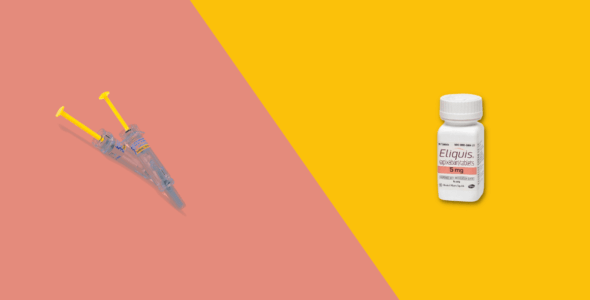Lovenox side effects and how to avoid them
Table of contents
Lovenox is a brand-name medication manufactured by Sanofi-aventis. It is classed as an anticoagulant and is used to treat heart disease. While Lovenox is generally well tolerated, there are some potential side effects that people should be aware of. The most common side effects of Lovenox include pain at the injection site. Less common, but more serious side effects, can include severe allergic reactions.
Learn more about the side effects of Lovenox and what you can do to avoid them.
What is Lovenox (enoxaparin)?
Lovenox (enoxaparin sodium) is a blood thinner that blocks certain proteins from forming blood clots. This helps reduce the risk of complications such as heart attacks or strokes. Lovenox is FDA-approved to treat the following conditions:
- Acute coronary syndromes such as ST-elevation myocardial infarction (STEMI), Non-ST elevation myocardial infarction, and unstable angina
- Prophylaxis of blood vessel complications of unstable angina (chest pain) and non–Q-wave myocardial infarction (MI)
- Deep vein thrombosis (DVT) prophylaxis in abdominal surgery, hip replacement surgery, knee replacement surgery, or bedridden patients
- Pulmonary embolism (PE)
- Prevention and treatment of venous thromboembolism (VTE)
- Treatment for prosthetic valve thrombosis in pregnancy
- Percutaneous coronary intervention (PCI)
The active ingredient in Lovenox is called enoxaparin sodium. It is a low molecular weight heparin that helps to treat blood clots or prevent them from happening by disrupting the clotting process. A complex chemical process causes your blood to clot. One step of this process is controlled by an enzyme called clotting factor Xa. Enoxaparin sodium stops your blood from clotting by deactivating clotting factor Xa. It stimulates a protein that’s already in your blood, called antithrombin, to attach to clotting factor Xa, stopping it from working. This disrupts the clotting process and makes it harder for your blood to form clots.
Lovenox dosage
Lovenox is available in injection form, in the following doses: Prefilled syringes: 30 mg/0.3 mL, and 40 mg/0.4 mL, Graduated prefilled syringes: 60 mg/0.6 mL, 80 mg/0.8 mL, and 100 mg/1 mL, Multiple-dose vials: 300 mg/3 mL, and 150 mg/mL, Graduated prefilled syringes: 120 mg/0.8 mL, and 150 mg/1 mL.
You take Lovenox by injecting it under your skin (subcutaneously), using a pre-filled syringe. Be sure to rotate your injection site with each daily dose. Lovenox has a half-life of up to 7 hours, and its anticoagulant effects last up to 12 hours. Due to this and its predictable effects, Lovenox does not need extensive monitoring or supervision.
If you miss a dose, use it as soon as you remember. If it is almost time for your next dose, skip the missed dose and use your next dose at the normally scheduled time.
Use a Lovenox needle and syringe once and then place in a sharps container, following your local or state laws on how to dispose of your sharps container.
Store Lovenox at room temperature between 15°C-30°C. Discard any unused Lovenox from the multiple-dose vials 28 days after the first use. Store Lovenox in a cool, well-ventilated, dry place away from direct sunlight.
You are advised to read the medication guide provided with this medicine for the full drug information and patient information and to speak with your healthcare provider for medical advice about any changes to your dose so they can monitor and evaluate your condition.
Lovenox side effects
The most common side effects of Lovenox in clinical trials include:
- Bleeding gums, nose bleeds, and vaginal bleeding
- Swelling (edema)
- Pain at the site of injection
- Nausea
- Diarrhea
- Fever
- Anemia
- A discoloration of your skin caused by bleeding or bruising under it (ecchymosis)
- Shortness of breath, trouble breathing
- Confusion
- A low blood platelet count (thrombocytopenia) – may show up in blood tests
- A high level of the enzyme aminotransferase in your blood – may show up in blood tests
More serious side effects of Lovenox include:
- Severe allergic reactions to the medication
- An increased risk of major bleeding events, like hemorrhage (bleeding from a ruptured blood vessel)
- Epidural catheter or spinal hematomas (bleeding and accumulation of blood in your spine). These can be caused by medications like Lovenox in medical patients who receive a spinal puncture or local anesthetic injections around their spine – this could result in permanent paralysis
Contact your healthcare provider for medical advice about any side effects you experience while taking Lovenox. You can report your side effects to the FDA at 1-800-FDA-1088 or www.fda.gov/medwatch.
Lovenox drug interactions
When Lovenox is taken with other medicines, they may interact and change how they work. They can also change the frequency and severity of side effects. Make sure your doctor is aware of all prescription drugs, over-the-counter medications, vitamins, and herbal supplements you take. Some major drug interactions with Lovenox include:
- Blood thinners or anticoagulants such as warfarin, clopidogrel, rivaroxaban and dipyridamole
- Nonsteroidal anti-inflammatory drugs (NSAIDs) such as aspirin, ibuprofen, and naproxen
- Herbal supplements such as ginkgo biloba, fish oil, and garlic
Lovenox warnings & precautions
You should not use Lovenox if you:
- Are allergic to enoxaparin sodium or any of the other ingredients in Lovenox
- Are allergic to any other heparin, or other low molecular weight heparins such as nadroparin, tinzaparin, or dalteparin
- Are allergic to any pork products
- Are allergic to benzyl alcohol
- Are bleeding heavily, or have a condition with a high risk of bleeding
- Have ever had a reaction called heparin-induced thrombocytopenia which causes a severe drop in platelets
- Are under 18 years of age
Talk to your doctor before taking Lovenox if you:
- Are taking any of the medications that could interact with Lovenox
- Have a susceptibility to bleeding
- Have previously had any bleeding problems
- Have a prosthetic heart valve
- Have uncontrolled high blood pressure
- Have a history of stomach ulcers (gastrointestinal ulceration)
- Have diabetes
- Have had eye damage caused by a complication of diabetes (diabetic retinopathy)
- Have severe kidney disease
- Have severe liver problems
- Are pregnant or are planning to get pregnant
- Are breastfeeding or are planning to breastfeed
- Are over 65 years of age
- Are going to have an operation that involves a lumbar puncture or local anesthetic injections in and around your spine
You should always check with your doctor or pharmacist before taking any medication, including Lovenox, to make sure it is safe for you.
How to avoid Lovenox side effects
The best way to avoid side effects is to take Lovenox as directed by your doctor. Follow your doctor’s instructions carefully and do not take more or less than prescribed.
If you experience any side effects, talk to your doctor or pharmacist. They may be able to recommend ways to help reduce or prevent some of the side effects.
1. Stick to the recommended dosage
Take your prescribed dose of Lovenox that has been recommended by your healthcare professional. Do not take more or less than prescribed.
2. Monitor your blood sugar levels
If you have diabetes, it is important to monitor your blood sugar levels closely while taking Lovenox. Check your blood sugar levels as directed by your doctor and report any changes to your doctor immediately.
3. Drink plenty of fluids
Drink eight to 10 glasses of water or fluids every day to help prevent dehydration, which can make side effects worse.
4. Avoid alcohol
Avoid drinking alcohol while taking Lovenox as it can increase your risk of bleeding.
5. Don’t skip meals
Eating regular meals and snacks will help to prevent low blood sugar levels (hypoglycemia).
6. Check your feet
If you have diabetes, check your feet for any cuts, sores, or redness regularly. Tell your doctor if you experience any problems with your feet while taking Lovenox.
7. Know the signs and symptoms of Lovenox side effects
Signs and symptoms of side effects include nausea, diarrhea, and fever. If you experience any of these symptoms speak to your doctor for medical advice.
8. Monitor your weight
Lovenox does not cause weight gain or weight loss. If you experience changes in your weight while taking Lovenox, get medical advice from your doctor.
9. Tell your doctor about all medications you’re taking
Be sure to tell your doctor about all other medications you’re taking, including over-the-counter drugs, vitamins, and herbal supplements, as they can interact with Lovenox.
10. Get regular medical check ups
It is important to get regular medical check ups and monitor your medical conditions. Your doctor will monitor your side effects and may adjust your dose of Lovenox as needed.
Medically reviewed
A medical professional has reviewed this article.


Jamie Winn, PharmD
Jamie Winn, PharmD
Dr. Jamie Winn received his Doctor of Pharmacy in 2002 from the University of South Carolina College of Pharmacy, Columbia, SC. Jamie is a medical reviewer for NiceRx.


